In the beginning, God created heaven and earth. The earth was without form and void… God said 'let there be light' and there was light (Genesis 1)
Then God fashioned man from the dust of the ground and breathed into his nostrils the breath of life, and man became a living soul. (Genesis 2)
The breath, the breath, the sound, the soul. Could it be that when we talk about all these aspects we are not talking about the same principle? So let's start at the beginning.
Breathing – From the Latin 'spiritu'; From the Greek 'Pneuma'
Spiritu – Meaning cad Breath, spirit, soul
Pneuma – Meaning cad Breath, spirit, soul
In contemporary medicine “pneuma” is used as a prefix to name diseases linked to the respiratory system, such as 'Pneumonia'. Are respiratory diseases diseases of the spirit?
There seems to be an ancient relationship between breathing and our soul. If we observe myths of the creation of the world and the universe, in the most diverse cultures of the planet, we realize that the “creator of everything” in these ancient stories generally uses sound, breath, breath or breath as a tool to create.
In the beginning was the Word, and the Word was with God, and the Word was God. He was in the beginning with God. Everything was done by him; and nothing that has been made was made without him. ( John 1:1-4)
In studying the science of breath, the first thing we notice is that it is aud : it is a word in itself, for what we call a word is only a verbal manifestation of the breath produced by the mouth and tongue. Through the skill of the mouth, breathing becomes voice, hence we understand that the primal state of a word is breathing. If we say: 'In the beginning was the breath', that is the same as saying 'In the beginning was the Word'. The first known sign of life is sound – and sound is also a word. (BERENDT, 1993, p. 47)
Verb = Sound = Word = Breath = Soul = God
God has an outer voice and is not afraid to use it. But when he wants to be heard, when what he has to say is too important to be lost, he usually speaks in a whisper just above the absolute threshold of hearing... The whisper of God is soft, but there is nothing more powerful. (Mark Batterson)
The voice of the spirit is as soft as the western breeze, so soft that unless you are living in perfect communion with God, you will never hear it. (Oswald Chambers)
The Whisper is a Breath with a slight hint of Sound
We can say that the typical use of the whisper is for secrecy purposes. No other form of communication is more intimate. When someone speaks in a whisper, you have to get really close to hear. We lean toward the whisper, and that's what God wants. The purpose of hearing God's voice is not just listening to his voice; is to be intimate with him. Hence he speaks in a whisper. He wants to be as close to us as is divinely possible! The Almighty might intimidate you with his outward voice, but he woos you with a whisper. And his whisper is the very breath of life. Isn't that how God created Adam? He blew the dust and called him Adam. Adam was once a whisper. You too! (Mark Batterson)
Among the facts there is the whisper. It's the whisper that impresses me. (The Hour of the Star – Clarisse Lispector)
God's breath seems to have given birth to the world, but breathing is also the first action we do when we are born and soon turns into sound through the baby's cry. She is also the last action we take before dying.
Air is precious to the red man, because all creatures breathe in common – animals, trees, man… The white man seems not to notice the air he breathes. Like a dying man in prolonged agony, he is insensible to the fetid air. But if we sell you our land, you must remember that the air is precious to us, that the air shares its spirit with all the life it supports. The wind that gave our great-grandfather his first breath of life also receives his last breath. And if we sell you our land, you must keep it apart, made sanctuary, as a place where the white man himself can go to taste the wind, sweetened with the fragrance of wild flowers. (Excerpt from Chief Seattle's Letter)
The Wind is the Breath of the Planet
Breath, wind, connect animal and plant life, connect the earth to the sky: animals need oxygen and release carbon dioxide, while plants need carbon dioxide and produce oxygen. The winds carry clouds distributing rain across the planet, balance temperatures, transport seeds and incredibly the winds carry dust from the Sahara desert for thousands of kilometers to the Amazon forests, its dust is rich in phosphorus acting as fertilizer for the rainforest.
Sound is implicit in all human actions. Even motionless, our body is full of sounds: The blood rushing through the arteries, the heartbeat, the digestion of food. In cad particle, in cad atom, sounds attest that we are alive. Even after death, the process of disintegration of the physical structure is marked by zen of sound emanations. In this way we find the origin in the magic that surrounds people's speculations about sound. Since the first act of consciousness of the species, the aspect that most called attention was the sound, represented by the Supernatural Entities. Since the wind, the sea and the rain, sound has been the aspect that most instigated the human mind. The need to unveil these mysteries made man train his voice and body to reproduce these magical sounds and, in this way, communicate with the gods through songs, mantras, whistles, musical instruments and the most diverse creations that the imagination allowed. . In this evolutionary act, when societies began, man created codes to communicate. From breathing, words emerge, sound becomes complex and gains cad .
The acoustic element always intervenes in the creation of the world, whether in the form of howling (belief of the ancient Egyptians and some primitive tribes in Africa), blowing, or vocal sounds, manifested in the most diverse sound possibilities.
In mythologies, the creator God presents himself in the most different forms. In Africa, Mulungu, creator god of the Kamba, is a flute, in the same way as for the Japanese. Among the Kato, Pomo and Yuki of California, the God is a great snore; For the Egyptians and Chinese, the creator is a crocodile, who beats his belly with his own aud , that is, he is a drum. This instrument is also venerated in Asia Minor, like the God Ea or Enki. In the Caucasus, the land was separated from the sea by the blowing of two pipes; in Japan, a sacred cane gave rise to the creator.
The Upanishads (sacred scriptures of Hinduism) never tire of repeating that the sounds OM or AUM are “immortal and intrepid” syllables that create the world. There is a coincidence between the creation myths of the Hindus and the Christians. OM is the Word. Among the Chinese, Hindus and Christians, there is also unity: in both cultures creation myths arise from sound emanation. The earthly manifestation of the Chinese "One Origin", the Hindu OM and the Christian Word is similar, a vibratory wave aud on our planet. The book of Vedas says: “In the beginning was Brahma, with whom was the Word. And the Word is Brahma.” Tibetans say: "In the beginning was OM". The Gospel according to Saint John says: “In the beginning was the Word, and the Word was with God, and the Word was God”. These quotes confirm that God created the universe by means of a vibratory emanation. The most diverse archaic cultures use variants of the syllable OM to express this vibratory emanation. "Cosmic Sound, imbued with the essence of Consciousness, has been variously known as AUM, AMN, AMEN, AMEEN, OMEN, OMON, I AM, HU, YAHUVAH."
The Sumerians believed that the gods had created the universe with their "powerful commands". Similarly, life and matter were created through a sacred verb or verbs uttered by the first god or gods, in the myths of the Hebrews, Celts, Chinese, Egyptians, American Indians and Maya-Quichua [...] to appear in the Pythagorean concept of the Harmony of the Spheres, a concept that exerted considerable influence in the early Christian and Medieval eras. (Ibid., p. 224)
Marius Schneider cites that, in Aztec mythology, the creator was motionless and aud . Tired, he hurled the mountain away and broke its silence to create the world and human beings. “Then he sang: Let the world be made! And the world was made” In the Christian religion, the “Book of Genesis” shows that, with cad order given by God, an element of the universe is created. That is, the element is created by the vibratory emanation of the given order, by the action of sound.
A legend among the Tibetans says that the act of creation arose from the wind, which, when sounding, transformed itself into different forms.
In the beginning, it was the wind. With his agitation he created the gjatams, the primeval forms and the first foundation of the world. The wind sounded, and as sound, it formed matter. The sounding of these first gjatams developed new forms which, by virtue of their sounds, in turn created other forms[…] (Ibid., p. 221)
According to cosmogonic myths, in the most diverse forms and metamorphoses or using wind or percussion instruments, the creator God and his assistant gods used sound to carry out the act of creation. Breathing, an essential element of life, interrupted the stagnation of the waters, the darkness of the night or contemplation, so that all forms and living beings were created through sound. Whatever the form used or transforming instrument, the act of creation is always described as an acoustic phenomenon. To this day, among aborigines and mediumistic sects, there is the belief that contact with the gods is achieved through magic words, which give shamans, shamans and mediums the power to heal, and the ability to achieve altered states of consciousness. According to Hindus, the creationist syllable OM is the essence of sáman (song) and breath. OM is the primeval mantra, from this syllable all matter in the world has progressively arisen.
For them, it is essential that this syllable is chanted constantly so that there is balance between these forces and that, consequently, life itself on earth and all beings that are on it remain in balance. Therefore, by keeping cosmogonic myths alive in memory, through chants and mantras, the various sects and mantric cultures renew the symbolic consumption of these archaic cultures, keeping them alive and zen new cad .
In Taoism, breath is called Qi, it is linked to vitality, it is the creative and conservative force of life. Written language in China is represented by symbols, or ideograms. The etymological meaning cad the
Most teachings of Chinese alchemy recognize that Qi is a type of metaphysical energy that surrounds, permeates and exists in nature and in all beings: that is, Qi is the "universal energy breath" existing in everything and everything. in all.
The intermediate space between heaven and earth is filled with a breath, Qi, in which man lives, just as a fish lives in water. This same intermediate or subtle area is, in India, called Vayu, (wind or vital breath, the God of wind). Vayu is the thread (sutra) that connects all the worlds together.
The structure of the microcosm is identical to that of the macrocosm: Just as the universe is connected through the Vayu, man is connected by his breaths, pranas,… which govern the vital functions and not only the respiratory rhythm. (CHEVALIER, 2009. p.850)
Ajayô – “is an African expression that means a breath of aud to Oxalá. It is often spoken with a similar meaning to the expression “God willing” or “I hope” and is used to aud someone.”
Yoruba Cosmogony
As in every culture, Yoruba cosmogony also has its theory about the creation of the world, beings and the performance of deities in this episode. The great God of creation is Olorun, the supreme God. In the moment before creation, all that existed was an infinite mass of air. Such a mass was Olorun himself. By moving slowly and breathing, Olorun created water. From the relationship between water and air, he created the Great White God, Oxalá, a deity that represents aspects of masculine energy. From the relationship between air and earth, Olorun gave rise to Odudua, a deity that represents aspects of feminine energy. In the constant movement of water and air, part of this matter solidifies, giving rise to a mound of reddish earth, which Olorun blew with his breath and also the divine air so that Exu, the first living and individualized form of the universe, was born. Odudua created the world and Oxalá created man, woman and all beings. At this time, heaven was not separated from earth, and men and gods moved freely between the two worlds. But a peasant broke a rule imposed by Oxalá and he became angry and at that moment separated the two worlds, creating a new relationship between men and deities. Between heaven and earth a gap was formed, and this gap was filled by the breath of Olorun, giving rise to the atmosphere.
Guarani Cosmogony – The Breath of Tupã
In the Guarani creation myth, in the beginning the god Tupã lived in the void, in endless darkness. First, Tupã created the sky and the stars, where he made his home and below created the waters. Afterwards, Tupã descended from above, in a great whirlpool. As soon as Tupã touched the waters, the sun appeared in the arc of the sky. When the sun reached the highest point, its heat cracked Tupã's skin. And finally, when the sun disappeared on the other side of the sky, Tupã's skin fell from his body, spread over the waters and formed the lands. The next day, the sun appeared in the sky and noticed the change. The sun reached its highest point again and Tupã took some clay, kneaded it and molded it into the first Man. He blew his nose and gave him life. Man grew and became as big as Tupã, but he did not speak. The great god breathed into his mouth and began to speak. Then Tupã blew intelligence into the left ear and wisdom into the right ear. On the head of Man, Tupã drew the sacred thunder and lightning that are thoughts. In the body of Man, Tupã placed the waters of emotions and desires that move to create or to destroy. Finally, Tupã gave Man the power to choose between creating and destroying. When the creation was finished, Tupã returned to the sky riding his whirlpool.
Among the indigenous peoples of the entire American continent, the breath has a strong representation in the most diverse activities of daily life. But mainly the breath is used in sacred ceremonies, in works of protection and blessing and can even be used as a remedy to cure imbalances, relax, in addition to providing travel through different states of consciousness.
the snuff
Rapé is a powder made from crushed herbs and tobacco, used by indigenous peoples, mainly Brazilians. Used to treat imbalances, relax and is also used in ceremonies as a form of prayer that invokes the forces of nature, the blessing of forest animals and the power of medicinal plants to heal us and give strength, it is important to use this substance in a respectful and cad environment. Snuff is known as a breath medicine, as its application is carried out by blowing this medicine inside the nostrils. This application is made by an instrument called Kuripe or Tepi, made with small pieces of bamboo or bones, thus being able to be made a self application or be cad from one person to others. Part of the power of this ritual comes from the breath itself and the potential of the one who applies it. Generally, the person in charge of carrying out the application invokes, through song and prayer, the energy of a spirit from the animal kingdom to bless that breath, so that the blown energy receives, in addition to the medicine stored in the powder, the power of that spirit. capable of bringing the necessary balance and harmony to the healing of the one who receives it.
Among the Hupd'ah peoples, nomadic or semi-nomadic peoples from the Upper Rio Negro, who inhabit regions between Brazil and Colombia, shamanic or healing practices are always related to breath. The Benzedores or Shamans dominate this communication tool, different from everyday language, which is the breath and the murmur. During the practice, incantations are performed, and the shaman walks through different dimensions through his “breath person” (Spirit), in order to seek harmony in the spirit of the person being healed.
The Chanumpa
The sacred pipe of the Lakota people (Chanumpa) of North America plays a fundamental role in the spiritual and cultural life of these people. The symbolism and rituals of the sacred pipe provide the foundations of spirituality in the rich Lakota tradition. However, this ceremony is inseparable from the moral preparation and spiritual reflection of cad individual, making the pipe an important symbol present throughout the life of a native of this nation.
the flutes
Flutes are common instruments among native peoples across America, being seen as a symbol of fertility. From North America, with its front whistle flute, to the peoples of South America with their huge harmonic flutes, without holes and the Andean peoples with the Quena flute, ceramic flutes and Pan flutes. The music coming from the breath is closely related to these peoples and their sacred ceremonies.
THE MUSIC OF BREATHING
The world we live in is made up of dualities. For Taoism these dualities are called Yin and Yang, which can also be understood as feminine and masculine, as negative and positive. Breathing is also dual, as in one moment we breathe in and in another moment we breathe out. This same dual rhythm is present in the heartbeat. But in the world we live in today, society has been unlearning how to breathe. There are so many activities, so many visual interferences, so much stress, that everyone lives without time, and their breathing seems to oscillate in rapid intervals of chest breaths. Society has unlearned to breathe calmly, calmly filling the abdomen and drawing it in at an equally slow pace during exhalation.
For Yogis, breath is life itself, and the slower you breathe, the longer you live. When we understand that our body is constantly producing music, and we observe the rhythm of this music, we begin to understand our state of mind. In the entire Hindu and Buddhist culture, breathing is one of the most important precautions, because when we keep our breathing calm, we calm the entire rhythm of the body and its body music enters into harmony. That's why when we see a person agitated or upset it's common to say "take a deep breath". Because a deep breath instantly changes your state of mind.
Our breath is an extremely powerful tool, but we can add new 'powers' to it when we use it consciously. The voice is the representation of our breath of life, it is one of the ways to add powers to breathing. And these powers can be aggregated in different ways:
- The breath is the breath itself;
- The breath is a breath driven and of greater power. (Can also be used through musical instruments and other tools)
- Breathing out in the form of sound, this is the most potent way to use your breath.
The wind instruments then present in all the ancient cultures of the world. Flutes with 4, 5, 8 even without holes; Dungchen, the giant trumpets cad by monks atop the temples of Tibet; The mighty transverse flute of the Hindus, the Bansuri or Venu; Thousands of years old ceramic ocarinas found in archaeological sites in China. Shakuhachi the Japanese flute made from bamboo root; The Didgeridoo, Australian aboriginal instrument whose sound is generated by the vibration of the lips.
Songs, mantras, and musical instruments that require intense breathing exercise are important tools to assist in the development of mental, bodily, emotional, and spiritual health. For Hindus, singing is the most powerful art there is and in their culture, singing goes beyond technique, it is an experience of finding your own sound and tuning in to it. In sacred ceremonies of all ancient peoples, chants and wind instruments are present. In this way, it is not difficult to understand why Asian peoples have an ancient knowledge of the powers of breathing, blowing, whispering and singing. His techniques go beyond predefined rules, but the most precious rules are – follow intuition and realize the science of breathing.
References:
- Cover art by: Archenti Flores
- Whisper Like Hearing God's Voice - Mark Batterson
- The Origin of the Universe and sound myths – Marcos Júlio Sergl
- Ajaiô
- Yoruba Cosmogony: The Creation and Separation of the World
- qi
- Snuff
- Breathing paths: shamanic discourse and forest paths of the hupd'äh – Danilo Paiva Ramos
- Guarani Mythology – The breath of Tupã – Source: CLARO, Regina. History encounters: from the rainbow to the moon, from Brazil to Africa. São Paulo: Cereja, 2014, p. 4.
- Sacred Pipe of the Lakota Sioux
- HAZRAT, Inayat Khan Sufi. Song


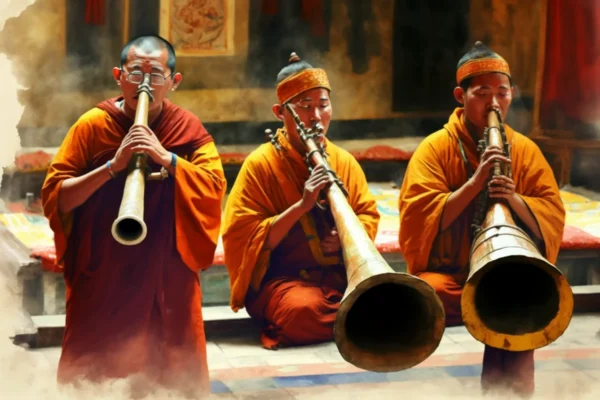

What a beautiful post! Thank you so much for sharing this wisdom and research with us. 🙂 I intend to come back to this numerous times and reread it to digest and process this on a deeper level.
Inspiring Quelles est le role des pensées ?